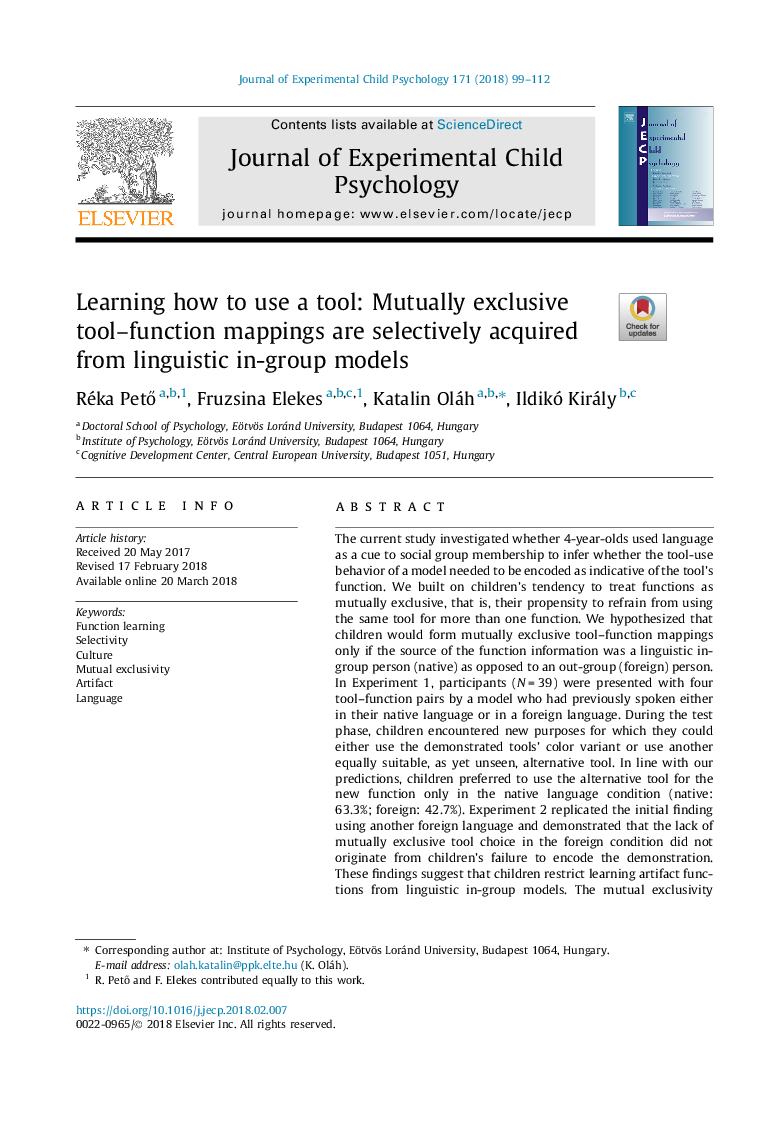| کد مقاله | کد نشریه | سال انتشار | مقاله انگلیسی | نسخه تمام متن |
|---|---|---|---|---|
| 7273965 | 1473441 | 2018 | 14 صفحه PDF | دانلود رایگان |
عنوان انگلیسی مقاله ISI
Learning how to use a tool: Mutually exclusive tool-function mappings are selectively acquired from linguistic in-group models
ترجمه فارسی عنوان
یادگیری نحوه استفاده از یک ابزار: مقادیر متفاوتی از ابزارهای کاربردی منحصربفرد از مدل های زبان درون گروهی به دست می آید
دانلود مقاله + سفارش ترجمه
دانلود مقاله ISI انگلیسی
رایگان برای ایرانیان
کلمات کلیدی
یادگیری تابع، انتخابی، فرهنگ، انحصار متقابل، غیرواقعی، ساختگی، زبان،
موضوعات مرتبط
علوم انسانی و اجتماعی
روانشناسی
روانشناسی رشد و آموزشی
چکیده انگلیسی
The current study investigated whether 4-year-olds used language as a cue to social group membership to infer whether the tool-use behavior of a model needed to be encoded as indicative of the tool's function. We built on children's tendency to treat functions as mutually exclusive, that is, their propensity to refrain from using the same tool for more than one function. We hypothesized that children would form mutually exclusive tool-function mappings only if the source of the function information was a linguistic in-group person (native) as opposed to an out-group (foreign) person. In Experiment 1, participants (Nâ¯=â¯39) were presented with four tool-function pairs by a model who had previously spoken either in their native language or in a foreign language. During the test phase, children encountered new purposes for which they could either use the demonstrated tools' color variant or use another equally suitable, as yet unseen, alternative tool. In line with our predictions, children preferred to use the alternative tool for the new function only in the native language condition (native: 63.3%; foreign: 42.7%). Experiment 2 replicated the initial finding using another foreign language and demonstrated that the lack of mutually exclusive tool choice in the foreign condition did not originate from children's failure to encode the demonstration. These findings suggest that children restrict learning artifact functions from linguistic in-group models. The mutual exclusivity principle in the domain of function learning is used more flexibly than previously proposed.
ناشر
Database: Elsevier - ScienceDirect (ساینس دایرکت)
Journal: Journal of Experimental Child Psychology - Volume 171, July 2018, Pages 99-112
Journal: Journal of Experimental Child Psychology - Volume 171, July 2018, Pages 99-112
نویسندگان
Réka PetÅ, Fruzsina Elekes, Katalin Oláh, Ildikó Király,
